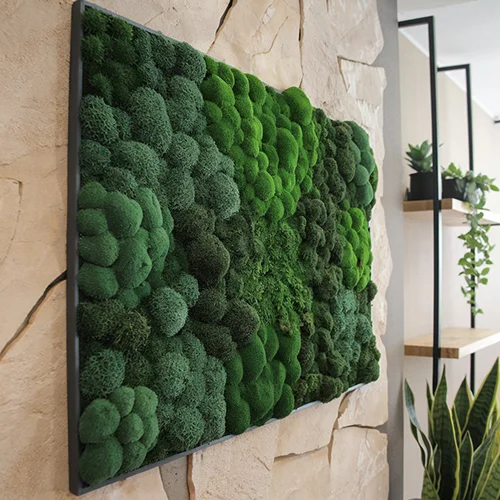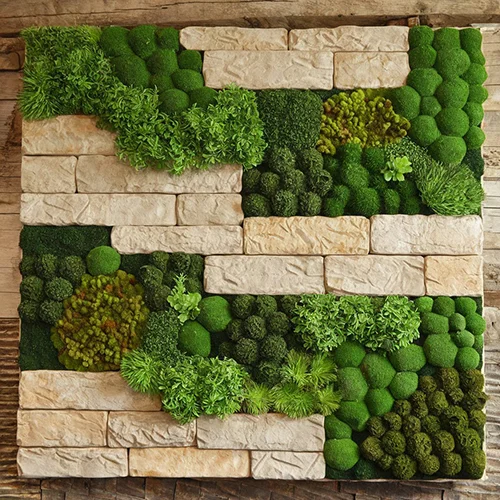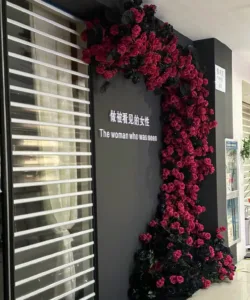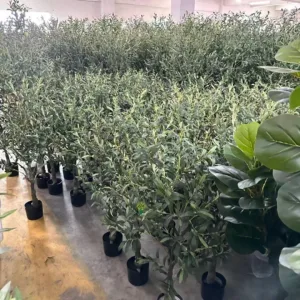In an age where urban living often distances us from nature, the trend of bringing the outdoors in has become more popular than ever. Incorporating greenery into indoor spaces is not just about aesthetics—it’s also about creating an environment that promotes relaxation, reduces stress, and enhances our overall well-being. However, maintaining a vibrant green space in our homes or offices can be challenging, especially for those who may not have the time or the ideal conditions for real plants to thrive. This is where artificial moss comes into play.
Artificial moss offers the perfect solution for anyone looking to create a lush, green space without the hassle of constant care. With advancements in materials and design, artificial moss has become increasingly realistic, durable, and versatile.
In this blog, we’ll explore how you can use artificial moss to transform your interior spaces into lush, green havens, complete with practical tips and creative ideas to help you get started.

Why Choose Artificial Moss?
Before diving into the tips and tricks, it’s important to understand why artificial moss is an excellent choice for creating indoor green spaces. Here are some key reasons:
A. Realistic Appearance of Artificial Moss
One of the primary advantages of artificial moss is its incredibly realistic appearance. High-quality artificial moss is designed to mimic the texture, color, and softness of real moss, making it nearly indistinguishable from the real thing. This means you can achieve the same natural look and feel without worrying about the environmental conditions that real moss requires, such as humidity, light, and proper soil.

B. Durability
Artificial moss is exceptionally durable, which makes it an ideal choice for both residential and commercial spaces. Unlike real moss, which can dry out, discolor, or become infested with pests, artificial moss maintains its lush, green appearance year-round. It is resistant to fading from sunlight, moisture, and other environmental factors, ensuring that your green space remains vibrant and fresh-looking for years.
C. Versatility
The versatility of artificial moss is another reason it’s becoming increasingly popular in interior design. It can be used in a wide variety of settings and applications, from large-scale installations to small decorative accents. Whether you want to create a dramatic moss wall, add subtle green touches to your decor, or experiment with unique design ideas, artificial moss offers endless possibilities.
D. Low Maintenance
Perhaps the most compelling reason to choose artificial moss is its low maintenance. Real moss requires specific care conditions, including consistent moisture, the right amount of light, and regular trimming. In contrast, artificial moss needs virtually no upkeep. You don’t need to water it, worry about pests, or deal with the mess that can come with real plants. This makes it an ideal option for busy individuals or for use in environments where plant care might be difficult, such as offices or commercial spaces.
Tips for Creating a Lush Green Space with Artificial Moss
Now that you understand the benefits of artificial moss, let’s delve into how you can use it to create a lush, green space in your home or office. Here are some practical tips to help you get started:
A. Start with the Right Space
The first step in creating a green space with artificial moss is selecting the right area in your home or office. The location you choose will significantly impact the overall look and feel of your green space.
Description:
Consider areas that are highly visible and would benefit from a touch of greenery. For example, living rooms, entryways, and conference rooms are all excellent choices for creating a green focal point. Additionally, think about the existing decor and lighting in the space. Artificial moss works well in both well-lit and low-light areas, but it’s essential to ensure that the surrounding decor complements the green tones of the moss.
Tips:
• Choose a space that naturally draws attention, such as a wall that is already a focal point in the room.
• Consider the size of the area you want to cover. A large, open wall might be ideal for a moss wall installation, while smaller spaces can be accented with moss panels or other decorative elements.
• Ensure the space has a suitable backdrop. Neutral colors like white, beige, or gray provide an excellent contrast to the vibrant green of artificial moss.

B. Combine with Other Green Elements
While artificial moss can be stunning on its own, combining it with other green elements can create a more dynamic and layered look. This combination can make your green space feel more natural and less uniform.
Description:
Pairing artificial moss with other plants—whether real or artificial—can enhance the overall aesthetic of your green space. For example, combining moss with artificial ferns, succulents, or trailing plants can add depth and variety to your design. The mix of textures and shades of green will create a more vibrant and lifelike environment.
Tips:
• Experiment with different types of greenery to see what works best together. For instance, the soft texture of moss pairs beautifully with the structured leaves of succulents or the delicate fronds of ferns. • Use planters, hanging baskets, or wall-mounted containers to arrange your green elements in a way that feels natural and cohesive. • Consider the placement of each element. Layering taller plants behind moss panels or placing trailing plants above a moss installation can create a cascading effect.
C. Use Artificial Moss to Create Focal Points
Artificial moss is an excellent material for creating focal points in a room. Whether you want to draw attention to a specific area or add visual interest to a dull space, moss can help you achieve this.
Description:
A focal point is an area in a room that draws the eye and anchors the space. Artificial moss can be used to create these focal points in various ways, such as through wall art, installations, or accent pieces. For example, a large moss panel framed and hung on the wall can serve as a striking piece of art that captures attention. Alternatively, you could use moss to highlight architectural features, such as a fireplace, staircase, or built-in shelving.
Tips:
• Frame a large piece of artificial moss and hang it as wall art in a central location, such as above a sofa or bed. • Create a moss installation that flows along the contours of a wall or ceiling to guide the eye through the space. • Use lighting to enhance the visual impact of your moss focal point. Spotlights or backlighting can create dramatic shadows and depth.
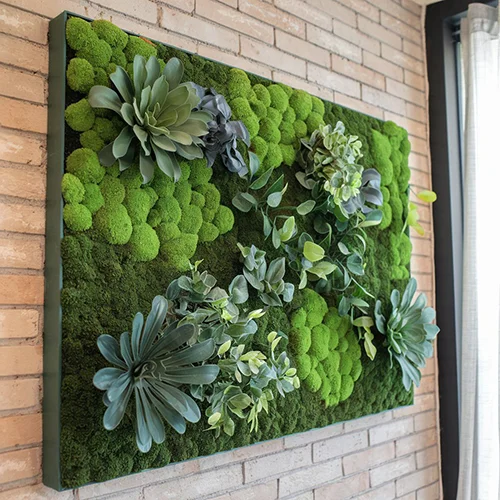
D. Experiment with Artificial Moss Accents
If you’re not ready to commit to a full moss wall or installation, consider using artificial moss as an accent in smaller, unexpected places. These accents can add a touch of greenery to your space without overwhelming it.
Description:
Moss accents are a subtle way to incorporate greenery into your decor. They can be used in various forms, such as lining trays, filling glass jars, or adding a pop of green to picture frames. These small touches can bring a natural element to any room and are particularly effective in spaces where a larger installation might not be practical.
Tips:
• Line decorative trays with artificial moss and use them as a base for candles, vases, or other decor items. • Fill clear glass jars or terrariums with artificial moss and display them on shelves, tables, or countertops. • Add a layer of moss to the base of potted plants or around the edge of planters for a more finished look. • Use moss to accent picture frames or mirrors, either by attaching it directly to the frame or by creating a moss border around the glass.
E. Pair Moss with Textures and Colors
Artificial moss is incredibly versatile, and pairing it with the right textures and colors can elevate your design. The key is to balance the lush green of the moss with other elements in your space.
Description:
The vibrant green of artificial moss can be complemented by a variety of textures and colors, depending on the look you want to achieve. Natural materials like wood, stone, and metal work particularly well with moss, as they enhance its organic feel. Additionally, choosing a color palette that contrasts or harmonizes with the green can create a more cohesive and visually appealing space.
Tips:
• Pair moss with wood elements, such as wooden frames, shelves, or beams, to create a rustic, natural look. • Use stone or concrete as a backdrop for moss installations to achieve a modern, industrial aesthetic. • Incorporate metal accents, such as copper, brass, or stainless steel, for a more contemporary or industrial vibe. • Choose complementary colors, such as earth tones, neutrals, or deep blues, to create a harmonious color scheme.
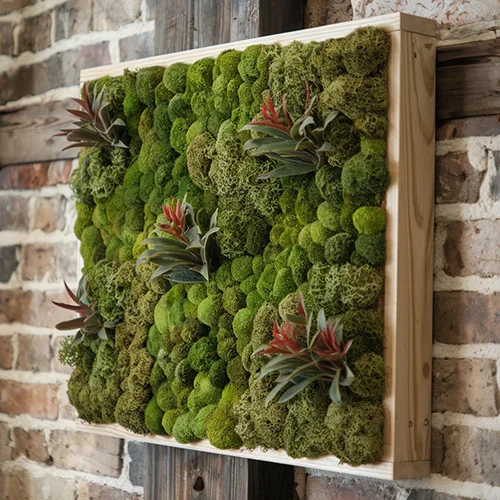
Creative Ideas for Using Artificial Moss
Beyond the traditional uses, there are several creative ways to incorporate artificial moss into your design. Here are some ideas to inspire you:
A. Vertical Gardens
Vertical gardens are a popular way to add greenery to a space without taking up floor space. Artificial moss is perfect for creating stunning vertical gardens that require no maintenance.
Description:
A vertical garden made with artificial moss can be as simple or as elaborate as you like. You can create a solid moss wall or mix moss with other plants and decorative elements for a more dynamic look. Vertical gardens are particularly effective in smaller spaces or areas where you want to make a bold statement without using traditional planters.
Tips:
• Choose a wall that receives plenty of natural light if you’re mixing artificial moss with real plants. However, if you’re using only artificial elements, lighting can be more flexible. • Consider the scale of your vertical garden. A full wall installation can be dramatic, but smaller, framed sections can be just as impactful. • Use a variety of textures and shades of green to create depth and interest in your vertical garden.
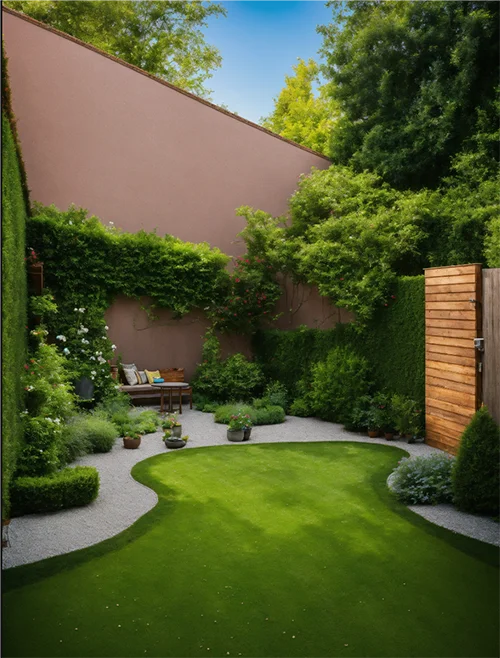
B. Moss-Covered Furniture
For a truly unique design statement, consider incorporating artificial moss into furniture. Moss-covered furniture can add a whimsical, natural touch to your space, making it feel like a part of an enchanted forest.
Description:
Moss-covered furniture can range from subtle accents, like moss-lined tables or chairs, to bold pieces where the entire surface is covered in moss. This approach is perfect for creating a focal point in a room or adding a touch of nature to an otherwise modern or industrial space. Whether you choose to cover the entire piece or just a portion, moss-covered furniture is sure to be a conversation starter.
Tips:
• Start small by adding moss to the edges or corners of furniture pieces, like coffee tables, chairs, or side tables. • For a more dramatic effect, consider fully covering the surface of a piece of furniture, such as a bench or an ottoman, with artificial moss. • Ensure the moss is securely attached to the furniture, especially if the piece will be used regularly. You may need to use strong adhesives or stitching for a more durable application. • Pair moss-covered furniture with minimalist decor to let the piece stand out, or integrate it into a themed room, such as a nature-inspired or rustic space.
C. Moss Pathways
Another creative idea is to use artificial moss to create indoor pathways. This concept can be particularly striking in larger spaces, such as open-plan offices, hallways, or entryways, where it can guide foot traffic while adding a natural element.
Description:
A moss pathway can be laid out in various patterns and designs, depending on the layout of the space and the look you want to achieve. You can create a straight path, a winding trail, or even a series of moss stepping stones. This approach not only adds greenery to your space but also creates a unique visual journey for those who walk through it.
Tips:
• Plan the layout of your moss pathway carefully to ensure it aligns with the natural flow of the space. Consider how people move through the area and place the moss accordingly. • Use contrasting materials around the moss to define the pathway clearly. For example, combine moss with stone, wood, or tile to create a striking contrast. • Ensure the moss is securely anchored to the floor, especially in high-traffic areas. You may need to use adhesives or secure the moss within frames or containers. • Consider adding subtle lighting along the pathway to highlight the moss and create a magical, inviting atmosphere.
Conclusion
Artificial moss is a versatile, low-maintenance solution for anyone looking to create lush green spaces in their home or office. From large installations like vertical gardens and moss walls to smaller accents and creative furniture designs, artificial moss offers endless possibilities for bringing a touch of nature indoors. By carefully selecting the right space, combining moss with other elements, and experimenting with different textures and colors, you can transform any space into a green oasis.
Whether you’re aiming for a bold, eye-catching statement or a subtle, natural enhancement, artificial moss can help you achieve the look you desire without the hassle of real plant care. So why not explore the world of artificial moss and see how it can elevate your interior design? With the tips and ideas shared in this blog, you’re well on your way to creating a lush, green space that will be the envy of all who see it.
